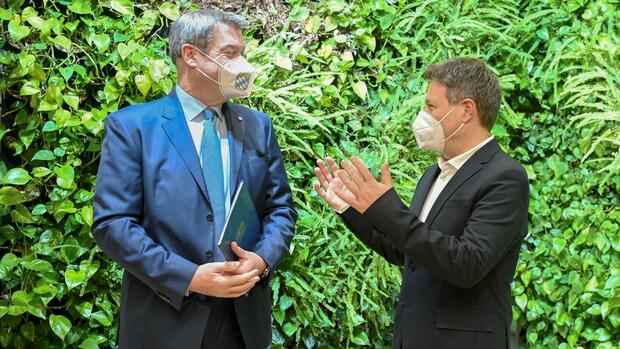The Green politician calls on the CSU leader to be ecologically patriotic about wind energy.
(Photo: Reuters)
Munich In the dispute over the expansion of wind power in Bavaria, the Free State should submit proposals by March on how capacity can be increased despite the controversial distance regulation. This is the result of a meeting between Prime Minister Markus Söder (CSU) and Federal Climate Protection Minister Robert Habeck (Greens) on Thursday in Munich.
“We also need ecological patriotism to expand difficult technologies such as wind power,” said Habeck. It is right to invest in solar or geothermal energy. However, the installation rates for wind would also have to increase.
The so-called 10-H regulation in Bavaria states that wind turbines must be at least ten times their height from residential buildings. Habeck sees the regulation as the main obstacle to the stuttering expansion of wind power in Bavaria. Söder considers other obstacles to be more crucial.
“We are ready to talk about exceptions,” said Söder. In principle, it is conceivable to soften the 10-H rule in the state forest, for example, and exceptions can also be imagined when replacing old systems with more modern and more powerful ones, so-called repowering, said Söder. “We’ll have to see whether that’s enough,” said Söder. With the proposals, Bavaria also wants to put wishes on the table, he announced.
Top jobs of the day
Find the best jobs now and
be notified by email.
“We believe that more is possible, but wind is not the main possibility in Bavaria,” said Söder, referring to wind power. Already, 53 percent of the electricity in Bavaria is generated from renewable energies. He rejected the demand to make two percent of the country’s area available for wind energy. “We’re just skeptical about the two percent,” said Söder.
Onshore wind energy in focus
Only about a dozen new wind turbines were built in Bavaria last year. This corresponds to about two percent of the total addition. For comparison: In Lower Saxony, more than 100 systems were built, which corresponds to almost a quarter of the new capacity nationwide.
The new federal government has set itself the goal of generating around 80 percent of electricity from renewable energies by 2030. Wind energy on land plays a central role in this. Two percent of Germany’s area is to be reserved for this purpose. In recent years, the expansion had come to an almost complete standstill due to a lack of space.
As early as 2023, five gigwatts of output are to be added, which would build on the record year 2017. By 2027 it should even be twice as much at ten gigawatts a year.
More: Habeck wants to help electricity and gas customers: “For many people, this winter is a real burden”
